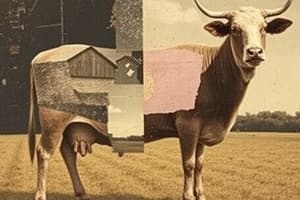Podcast
Questions and Answers
Molecules consist of atoms.
Molecules consist of atoms.
True (A)
Atoms are made up of cells.
Atoms are made up of cells.
False (B)
Cells are assembled from molecules.
Cells are assembled from molecules.
True (A)
Molecules are smaller than cells.
Molecules are smaller than cells.
Cells cannot form from combinations of atoms.
Cells cannot form from combinations of atoms.
Animal physiology is the oldest branch of zoology.
Animal physiology is the oldest branch of zoology.
Animal physiology dates back to at least 500 B.C.
Animal physiology dates back to at least 500 B.C.
Zoology only includes the study of mammals.
Zoology only includes the study of mammals.
The study of animal physiology is a recent development in zoology.
The study of animal physiology is a recent development in zoology.
Understanding the branches of zoology requires basic knowledge of each.
Understanding the branches of zoology requires basic knowledge of each.
Flashcards are hidden until you start studying
Study Notes
Animal Physiology
- The study of animal physiology dates back to 420 B.C.
- It explores how animals function and interact with their environment.
Types of Nutrition
- Autotrophic nutrition: Organisms that obtain energy from sunlight.
- Examples include plants and bacteria.
- Heterotrophic nutrition: Organisms that obtain energy by consuming other organisms.
- Humans are heterotrophic.
Types of Digestion
- Intracellular digestion: Occurs within food vacuoles inside cells.
- The digested food diffuses into the cytoplasm.
- Extracellular digestion: Occurs outside of cells, in the gut lumen.
- Found in higher animals.
- Digested materials are absorbed into cells.
Building Blocks of Life
- Lipid (Fat) synthesis:
- When a glycerol molecule combines with three fatty acid molecules.
- Requires the removal of three water molecules.
- Called a condensation reaction.
- The ester linkage forms between the glycerol and the fatty acids.
- Lipid (Fat) breakdown:
- A triglyceride is broken down into one glycerol molecule and three fatty acid molecules.
- Requires the addition of three water molecules.
- Called a hydrolysis reaction.
- Protein synthesis:
- Large macromolecules formed from carbon, hydrogen, oxygen, nitrogen, and sulfur.
- Composed of amino acids linked together.
- Amino acids are joined by a peptide bond.
- Requires the removal of a water molecule (condensation reaction).
- Dipeptide: Two amino acids joined together by a peptide bond.
- The carboxyl group of one amino acid bonds to the amino group of the other amino acid.
Interesting Note
- The Mosquito is an example of a sanguivorous organism.
- This means it is a heterotrophic organism that feeds on blood.
Studying That Suits You
Use AI to generate personalized quizzes and flashcards to suit your learning preferences.




